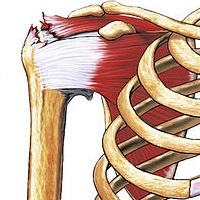
Photo from wikipedia
Objective To compare clinical data from the physical examination with arthroscopic findings in rotator cuff rupture. Methods A total of 177 patients submitted to arthroscopic treatment of rotator cuff rupture… Click to show full abstract
Objective To compare clinical data from the physical examination with arthroscopic findings in rotator cuff rupture. Methods A total of 177 patients submitted to arthroscopic treatment of rotator cuff rupture were selected, and arthroscopic findings were compared with physical examination. Results The impingement tests showed high sensitivity for rotator cuff rupture. Among the strength tests, the most sensitive was the Patte test (85.7%), and the one with the highest positive predictive value (PPV) was the Jobe test (95%). The Drop Sign test showed higher specificity and negative predictive value (NPV) (98.7 and 95.9%, respectively). Patients with a history of trauma were 3.5 times more likely to have a positive Lift Off test. Conclusion The impingement tests had high sensitivity for rotator cuff ruptures. The Jobe test showed similar sensitivity among patients who had partial or total supraspinal injury. For complete lesions of the subscapularis, The Lift Off and Belly Press tests showed high sensitivity and specificity.
Journal Title: Revista Brasileira de Ortopedia
Year Published: 2022
Link to full text (if available)
Share on Social Media: Sign Up to like & get
recommendations!